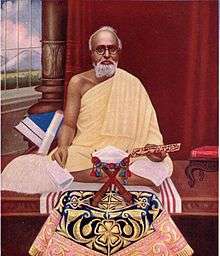Vallabhsuri
| Acharya Vallabhsuri | |
|---|---|
 | |
| Official name | Acharya Vijay Vallabh Suri |
| Religion | Jainism |
| Sect | Svetambara |
| Personal | |
| Born |
Chhagan October 26, 1870 Baroda (now Vadodara, Gujarat, India) |
| Died |
22 September 1954 (aged 83) Byculla, Bombay (now Mumbai) |
| Parents | Deepchand, Icchabai |
| Religious career | |
| Successor | Samudra Suri |
| Initiation |
Vallabhvijay 5 May 1887 Radhanpur by Vijayanandsuri (Atmaram) |
| Part of a series on |
| Jainism |
|---|
 |
|
Jain prayers |
|
Ethics |
|
Major sects |
|
Festivals |
|
|
Acharya Vijay Vallabhsuri was a Jain monk. He was a disciple of Vijayanandsuri. He worked for the religious as well as improving the social life of people. He worked in Punjab so he was given honorific Punjab Kesari.[1][2]
Life
He was born on 26 October 1870 (Second day of bright half of Kartik month, Vikram Samvat 1927) at Vadodara, Gujarat. He was named Chhagan.[2] His parents Deepchand and Ichhabai died in his early years.[3][4]
He met Vijayanandsuri at Janiseri Jain Upashray, Vadodara. At the age of 17 years, he was initiated as a Jain monk Muni Vallabhvijay on 5 May 1887 (Jayesth Vad 9, Vikram Samvat 1944) by Vijayanandsuri and became disciple of Muni Harshvijay at Radhanpur. In Vikram Samvat 1981, he was conferred the title of Acharya on Magshirsh Sudi 5 by Sumtivijay at Lahore. He also had the title of Pattadhar conferred on him by Jain sangha.[3][5][4]
Vallabhsuri was in Gujranwala for Chaturmas in 1947. Due to the partition of India, Gujaranwala fell in Pakistan. There was widespread communal violence across both nations. He refused travel by plane which was arranged by the Government of India as Jain monks do not use vehicles. He travelled by foot along with other Jains of Gujaranwala and entered India via the Wagah Border unharmed and reached Amritsar in September 1947.[3][4]
Throughout his life, Vallabhsuri placed emphasis on education and inspired Jains to build more educational institutions. He is well known as the founder of Shree Parshwanath Jain Vidyalaya in 1927 at Varkana Village in Pali district of Rajasthan. The seed which he sowed has taken shape of a dense tree in Godwad area of Rajasthan. He founded Mahavir Jain Vidyalaya (at Mumbai, Vadodara, Pune), Parshwanath Umed Mahavidyalaya (at Falna), Atmanand Jain College (at Ambala, Malerkotla), Atmanand Jain High School (Ludhiana, Ambala, Malerkotla, Bagwada, Hoshiarpur, Jandiala Guru) and other educational institutes.[2] He wrote some books and religious texts in Hindi, Gujarati, Punjabi Languages. He also established Atmanand Jain Sabha. He was also instrumental in establishing Jain unity and accessibility of Jain literature. He supported Mahatma Gandhi's non-violent movement for independence of India.[3][6][7][4][1]
He died on 22 September 1954 (Bhadrapad Vadi 11, Vikram Samvat 2010), Tuesday at 2:32 am in Byculla, Mumbai.[2][3][4] More than two lakh people attended his funereal procession.[1] A memorial dedicated to him was built there later.
Recognition
Vijay Vallabh Smarak, a memorial in Delhi was erected to honour him. It is managed by Shri Atma Vallabh Jain Smarak Shikshan Nidhi.[6] India Post issued a postage stamp of Vallabhsuri on 21 February 2009 which depicted his image along with Vijay Vallabh Smarak as a background image.
See also
References
- 1 2 3 Shah, Natubhai (1998). Jainism: The World of Conquerors. Motilal Banarsidass Publishe. pp. 54–55. ISBN 978-81-208-1938-2.
- 1 2 3 4 "Acharya Vijay Vallabh Suri". herenow4u.com. Retrieved 28 December 2012.
- 1 2 3 4 5 Kasturchand M. Jhabak (1974). The Life & Work of Acharya Vijaya Vallabh Suriji.
- 1 2 3 4 5 Muni, Punjyavijayji (1956). Acharya Shri Vijay Vallabh Suri Smrak Granth [Acharya Vijay Vallabhsuri Commemoration Volume]. Bombay: Shri Mahavir Jain Vidyalaya Prakashan. pp. 40–75.
- ↑ Peter Fl Gel; Peter Flügel (1 February 2006). Studies in Jaina History and Culture: Disputes and Dialogues. Routledge. p. 372. ISBN 978-1-134-23552-0.
- 1 2 Titze, Kurt (1998). Jainism: A Pictorial Guide to the Religion of Non-Violence. Motilal Banarsidass Publ. p. 136. ISBN 9788120815346. Retrieved 28 December 2012.
- ↑ John Cort (21 January 2010). Framing the Jina: Narratives of Icons and Idols in Jain History. Oxford University Press. pp. 9–. ISBN 978-0-19-973957-8.